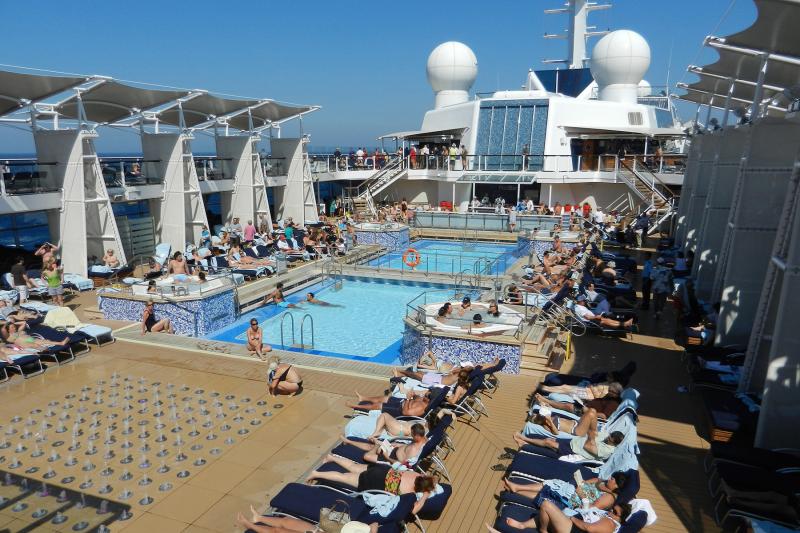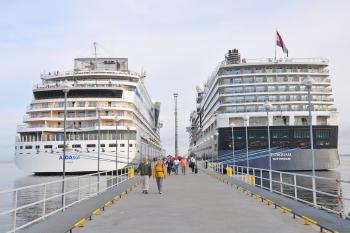Making the most of your cruise
This item appears on page 47 of the September 2018 issue.
Last year I spent two weeks on a Mediterranean cruise, filming a one-hour TV show* that will present an honest look at the pros and cons of cruising and will equip travelers with the knowledge they need to be smart cruisers.
You might not think of it as budget travel, but cruising can be extremely affordable. When you consider that the price includes accommodations, food and transportation to far-flung destinations, it's simply a steal. But reckless spending on a cruise can rip through a tight budget like a grenade in a dollhouse. Stay away from the casino, beware of the specialty restaurants, and keep to a budget if you order any liquor.
Here are a few more tips for making the most of your next cruise.
•
Arriving in your port city a day or more before your cruise gives you the chance to get over jet lag, see your departure city (which is generally not part of your cruise itinerary) and avoid the potential stress of missing your cruise. When you're ready to board, make sure you're not carrying forbidden items, ranging from a clothes iron to firearms to alcohol (most cruise lines don't let you BYOB).
Unpack thoroughly and thoughtfully right away. Clutter makes a small cabin even smaller. I pack heavier when cruising than when traveling on land (where the downside of packing heavy is much greater), so I make it a point to unpack completely, establishing a smart system for keeping my tight little cabin shipshape.
Deep-store items you won't need in your suitcase, which you can stow under your bed. Survey your storage options and use them smartly. For example, use one drawer for all things electronic, establish a pantry for all food items, and use the safe even if you don't bother locking it.
Unclutter the room by clearing out items the cruise line leaves for you (such as promotional materials). I establish one drawer for all paper material I think I'm done with.
And I have a ritual of toggling from shore mode to ship mode by putting my pocket change and money belt (neither of which are of any value on board) in a drawer or in the safe when I return to the ship. (By the way, many ships recommend that you generally leave your passport in your stateroom rather than take it ashore — advice I follow.)
•
Once you're settled, get out of your cabin and explore the ship. Study the ship's cutaway models on the signage, walk each deck, and find the many delightful little corners where you can take full advantage of your options.
To avoid crowds, participate in shipboard activities and use amenities at off-times. The gym is quieter late in the evenings, when many cruisers are already in bed. Onboard restaurants are typically less crowded for the later seatings. If you're dying to try out that rock-climbing wall, drop by as soon as you get back on the ship in the afternoon; if you wait an hour or two, the line could get longer.
Embarkation day can also work to your advantage: while other passengers are unpacking and exploring the ship, you'll have the mini-golf course to yourself.
I also recommend the "behind-the-scenes" ship tour (usually about $100). While pricey, it's an amazing 2-hour look at how the ship and its crew run the entire show in a parallel world that is invisible to most cruisers.
Ship geeks will marvel at how these newer massive ships no longer use an old-style shaft and propeller. These days, the behemoths are nimbly maneuvered by Azipods (pods with propellers that can rotate 360 degrees and, with the help of bow thrusters, jockey a 300-yard-long ship into any pier).
•
Most cruisers simply book the cruise line's shore excursions for $100 (or more) a crack and are generally happy they did. However, many other options open up to passengers once they step off the ship.
Some travelers may opt to find a small company with a sales office in the terminal and purchase essentially the same ship-excursion experience for about half the price.
Others will book a private guide with a car or minibus in advance (teaming up with other cruisers to share the expense).
And others, with a guidebook in hand, will simply hop on a public bus or hike to the train station and do their own thing. For the most reliable information, I recommend skipping the onboard excursion information desks. Instead, head to the tourist information kiosks that are set up to greet ships in each port.
Equipped with practical information, you're more likely to enjoy smooth sailing on your vacation, fully appreciating the economy, efficiency and fun that cruising offers.
*The show on cruising will air on public television in January 2019.
Rick Steves writes European travel guides and hosts travel shows on public TV and radio. Contact Rick Steves' Europe (Edmonds, WA; 425/771-8303, www.ricksteves.com).


